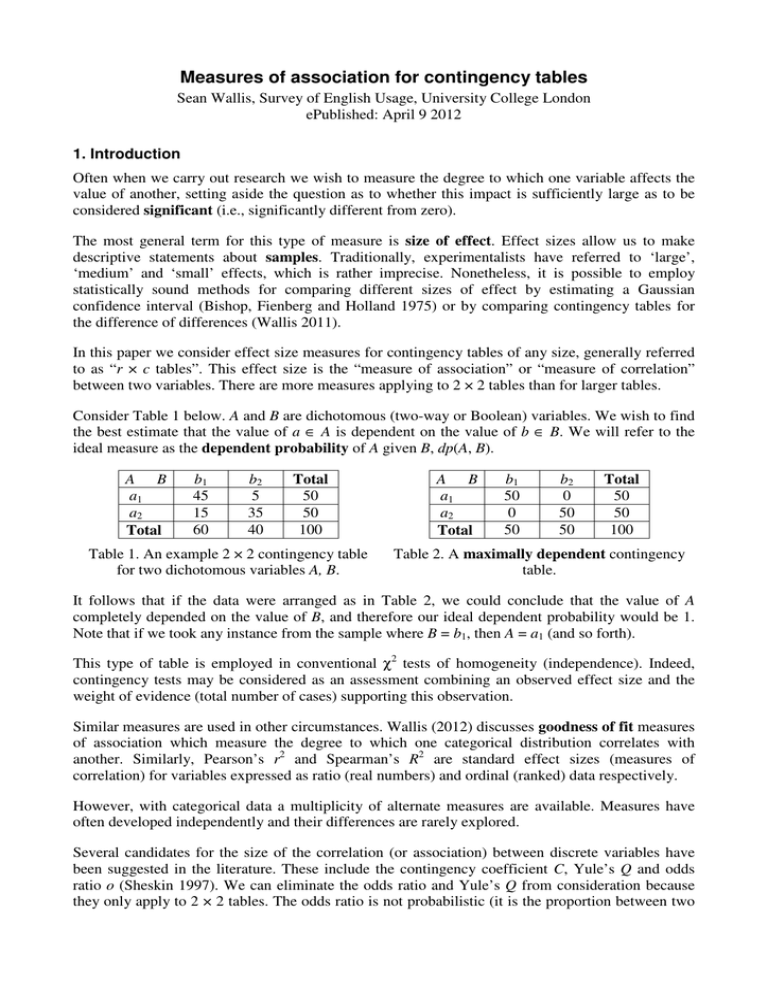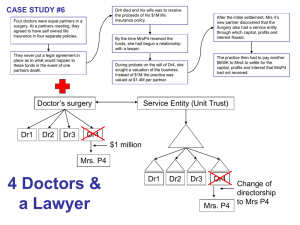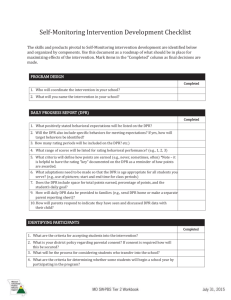Measures of association for contingency tables
advertisement

Measures of association for contingency tables
Sean Wallis, Survey of English Usage, University College London
ePublished: April 9 2012
1. Introduction
Often when we carry out research we wish to measure the degree to which one variable affects the
value of another, setting aside the question as to whether this impact is sufficiently large as to be
considered significant (i.e., significantly different from zero).
The most general term for this type of measure is size of effect. Effect sizes allow us to make
descriptive statements about samples. Traditionally, experimentalists have referred to ‘large’,
‘medium’ and ‘small’ effects, which is rather imprecise. Nonetheless, it is possible to employ
statistically sound methods for comparing different sizes of effect by estimating a Gaussian
confidence interval (Bishop, Fienberg and Holland 1975) or by comparing contingency tables for
the difference of differences (Wallis 2011).
In this paper we consider effect size measures for contingency tables of any size, generally referred
to as “r × c tables”. This effect size is the “measure of association” or “measure of correlation”
between two variables. There are more measures applying to 2 × 2 tables than for larger tables.
Consider Table 1 below. A and B are dichotomous (two-way or Boolean) variables. We wish to find
the best estimate that the value of a ∈ A is dependent on the value of b ∈ B. We will refer to the
ideal measure as the dependent probability of A given B, dp(A, B).
A B
a1
a2
Total
b1
45
15
60
b2
5
35
40
Total
50
50
100
Table 1. An example 2 × 2 contingency table
for two dichotomous variables A, B.
A B
a1
a2
Total
b1
50
0
50
b2
0
50
50
Total
50
50
100
Table 2. A maximally dependent contingency
table.
It follows that if the data were arranged as in Table 2, we could conclude that the value of A
completely depended on the value of B, and therefore our ideal dependent probability would be 1.
Note that if we took any instance from the sample where B = b1, then A = a1 (and so forth).
This type of table is employed in conventional χ2 tests of homogeneity (independence). Indeed,
contingency tests may be considered as an assessment combining an observed effect size and the
weight of evidence (total number of cases) supporting this observation.
Similar measures are used in other circumstances. Wallis (2012) discusses goodness of fit measures
of association which measure the degree to which one categorical distribution correlates with
another. Similarly, Pearson’s r2 and Spearman’s R2 are standard effect sizes (measures of
correlation) for variables expressed as ratio (real numbers) and ordinal (ranked) data respectively.
However, with categorical data a multiplicity of alternate measures are available. Measures have
often developed independently and their differences are rarely explored.
Several candidates for the size of the correlation (or association) between discrete variables have
been suggested in the literature. These include the contingency coefficient C, Yule’s Q and odds
ratio o (Sheskin 1997). We can eliminate the odds ratio and Yule’s Q from consideration because
they only apply to 2 × 2 tables. The odds ratio is not probabilistic (it is the proportion between two
probabilities), although the logistic function can be applied to obtain the log odds. In this paper we
consider three potential candidates: Cramér’s φ, adjusted C and Bayesian dependency.
Given this range of potential measures for effect size, two questions arise.
Do they measure the same thing? And if not, how may we choose between them?
2. Probabilistic approaches to dependent probability
2.1 Cramér’s φ
Cramér’s φ (Cramér 1946) is a probabilistic intercorrelation for contingency tables based on the χ2
statistic.1 We may compute φ from the formula
φ≡
χ2
N × (k − 1)
(1)
2
where N is the total frequency, k is the minimum number of values
2 of A and B, and χ is the
standard test for homogeneity. For 2 × 2 tables k – 1 = 1, so φ = √χ /N is often quoted.
Note that this formula neatly defines a relationship between χ2, φ, N and k. N represents the number
of cases (weight of evidence). k standardises tables with different numbers of rows and columns.
An alternative formula, for 2 × 2 tables only, obtains a signed result, where a negative sign implies
that the table tends towards the opposite diagonal.
φ≡
ad − bc
(a + b)(c + d )(a + c)(b + d )
.
(2)
Equation (2) does not generalise to tables with more than one degree of freedom, however. We will
therefore principally be concerned with absolute φ (equation 1).
2.2 Probabilistically adjusted C
A probabilistically adjusted C may be defined as follows (after Sheskin, 1997: 243),
Cadj ≡
χ2 ×k
.
(χ 2 + N ) × (k − 1)
(3)
No proof is required to show that this figure does not match φ!
2.3 Properties of φ
The following properties of φ are useful in interpreting scores, but are rarely summarised. For the
mathematically inclined we present a number of novel proofs in the appendices.
1. Limits. In a maximally skewed table such as Table 2, χ2 reaches a limit of (k – 1) × N. As
Cramér comments, the upper limit of φ, 1, is attained when and only when each row or column
contains one single element other than zero. Hence in the case of non-square tables, k is the
lower of the number of rows or columns.
Sometimes called Cramér’s V. Cramér (1946: 443) himself notes f 2 = χ2 / N and 0 ≤ f 2/ (k – 1) ≤ 1 “thus χ2 / N (k – 1)
may be regarded as a measure of the degree of association indicated by the sample.”
1
Measures of association for r × c tables
–2–
© Sean Wallis 2012
φ=0
F
b
¬b
a
/2
1
/2
1
¬a
1
/2
1
/2
φ=p
Φ
b
¬b
a
(p+1)
/2
/2
(1−p)
¬a
/2
(p+1)
/2
(1−p)
φ=1
I
b
¬b
a
1
0
¬a
0
1
Figure 1. φ measures the degree by which a flat matrix F is perturbed towards the identity matrix I.
φ has a value of 0 when there is no association between the two values, that is, when the
probability of selecting a value of A is constant for any value of B.
2. Interdependence. In Appendix 1 we prove that Cramér’s φ(A, B) φ measures the linear
interpolation from flat to identity matrix (see Figure 1 for the idea). We can therefore refer to φ
as the best estimate of the population interdependent probability idp ≡ p(a ↔ b). This
intercorrelation is robust, i.e. it ‘gracefully decays’ the further it deviates from this ideal. φ is
also closely related to the Pearson product-moment coefficient. It is a root mean square measure
of the orthogonal ‘distance’ from a maximal dependence line.
3. Direction. The concepts ‘interdependent’ and ‘dependent’ are distinct. Whereas dependent
probabilities (e.g. p(a | b)) are directional (p(a | b) ≠ p(b | a)), the interdependent probability is
not. The contingency correlation χ2(A, B) ≡ χ2(B, A), and therefore φ(A, B) ≡ φ(B, A).
Another way of thinking about φ is to consider that the table represents the flow of information
from B to A. If information about the value of B is irrelevant to the determination of the value of A,
the score is zero. Information does not ‘pass through’ the matrix.
3. A Bayesian approach to dependent probability
An alternative to the stochastic approach to dependence dp(A, B) can be constructed with a simple
Bayesian model.
Church (2000) compares the probability of a Bayesian ‘positive adaptation’ probability, p(+adapt),
with the prior probability p(prior) by measuring the probability of an event (the use of a selected
word) in two parts of the same text. The absolute change in the probability of selecting a given b is,
in Church’s notation, | p(+adapt) – p(prior) |. We can rewrite this simply as
absolute dependent probability dpA(a, b) ≡ | p(a | b) – p(a) |.
In Table 1 the chance of selecting a1 is 0.5 (50 out of 100) by default. This increases to 0.75 (45 out
of 60) if B = b1, i.e., the probability has increased by 0.25. This is an absolute difference. The
potential probability change is limited by p(a), so if p(a) is 0.5, dpA(a, b) can only reach 0.5.
This appears to be an underestimate. When the value of A is completely dependent on the value of B
(cf. Table 2) the dependent probability should be 1. We simply scale the probability change by the
available range:
p ( a | b) − p ( a )
1 − p (a )
relative dependent probability dpR(a, b) ≡
p ( a ) − p ( a | b)
p(a)
if p (a ) < p (a | b)
(4)
otherwise
Relative dependent probability will reach 1 for maximally dependent tables (such as Table 2).
We next consider summations. Where the value of B is known we could take the arithmetic mean of
values of A.
Measures of association for r × c tables
–3–
© Sean Wallis 2012
A B
a1
a2
Total
b1
b2
Total
45
15
60
5
35
40
50
50
100
B A
b1
b2
Total
a1
a2
Total
45
5
50
15
35
50
60
40
100
p(a | b)
0.75
0.25
p(b)
0.6
0.125
0.875
0.4
p(b | a)
0.9
0.1
0.5
p(a)
0.3
0.7
0.5
p(a)
dpR(a, b)
0.5
0.5
0.5
0.5
dpR × p(b)
0.75
0.75
p(b)
dpR(b, a)
0.6
0.4
0.5
0.5
0.3
0.3
½Σ
0.3
0.3
0.6
dpR × p(a)
0.75
0.75
0.25 0.375
0.25 0.375
½ Σ 0.625
Table 3. Summing Table 1 for the relative dependent probability of a given b (upper), and in the
opposite direction, b given a (lower).
dpR(A, b) ≡
1 k
∑ dpR (ai , b) ,
k i =1
(5)
Generalising across values of B we compute a weighted mean:
dpR(A, B) ≡
1 k l
∑∑ dp R (ai , b j ) × p(b j ) ,
k i =1 j =1
(6)
where k is the number of values of A and l the number of values of B.
When summed, relative change in probability is directional (absolute change is not). This is
demonstrated in Table 3. We briefly touch upon the interpretation of a directional correlation
measure in the next section.
In the case of a 2 × 2 table, equation (5) may be simplified to
dpR(A, B) ≡
[ p(a1 | b1 ) − p(a1 )] p (b1 )
,
[1 − p(a1 )] p(a1 )
(7)
where a1 and b1 are the first Boolean values of A and B respectively. This simplification is possible
because in a two-way table, p(a1) = 1 – p(a2).
Unlike equation (5), this equation is signed, i.e., it obtains a positive value when the upper left and
bottom right cells are greater than their alternates (in our case, when b1→a1 and b2→a2), and a
negative value when the opposite (b1→a2, b2→a1) holds. The derivation is given in Appendix 2.
The main advantage of this formula is ease of use. The first computation in Table 3 is simply:
dpR(A, B) = (0.75 – 0.5) × 0.6 / (0.5 × 0.5) = 0.6.
4. Evaluating measures
In order to explore the behaviour of these formulae we construct idealised contingency tables
defined in two steps. First, we interpolate a maximally dependent table ( Figure 1) and an equivalent
‘flat’ matrix with a parameter x ranging from an even distribution for each row {N(a)/k, N(a)/k…}
to the maximally dependent {N(a), 0…}. Each row has values {x, (N(a) – x)/k… } where the
frequency of the cell on the diagonal is x.
Second, each column in these tables is then weighted by a fixed prior probability p(b). This
introduces a directional bias into the model. We then plot a variety of dependent probability
measures against x.
Measures of association for r × c tables
–4–
© Sean Wallis 2012
1
1
2×2
3×3
0.8
0.8
φ
dpR(B, A)
0.6
dpR(B, A)
0.6
Cadj
φ
Cadj
0.4
0.4
dpR(A, B)
dpR(A, B)
0.2
0.2
0
0
10
15
20
10
15
20
25
30
Figure 2: Effect of uneven priors. Measures of dpR, Cadj and φ for idealised k × k tables with
uneven prior probability p(b) plotted against dependency factor x, k = 2 (left) and k = 3 (right).
Figure 2 visualises the relationship between φ, Cadj and Bayesian dpR. The left graph plots
dependency measures for a 2 × 2 table where N(a)/k = 10 and p(b) = {1/6, 5/6}. The right graph
does the same for a 3 × 3 table where p(b) = {1/9, 4/9, 4/9}.
We note the following.
1. Relative dependency dpR(B, A) is linear with x when p(a) is even.
2. Measures are ordered in size: Cadj > dpR(B, A) > φ > dpR(A, B).
3. dpR(A, B) (and therefore φ) converges to dpR(B, A) as p(b) becomes more even (tends to 1/k).
Whereas dpR measures the distance on the first parameter from the prior (and is thus directional
when a prior skew is applied to one variable only), φ is based on the root mean square distance of
both variables. Cadj appears to behave rather differently to φ, as the right hand graph in Figure 2
shows. Given that the only other bi-directional measure, φ, measures the interdependence of A and
B, there appears to be little advantage in adopting the less conservative Cadj.
Finally, for k = 2 the following equation also holds:
4. φ2 = dpR(A, B) × dpR(B, A).
We find an equality between a classical Bayesian approach to dependency and a stochastic
approach based on Pearson’s χ2 for one degree of freedom. The proof is given in Appendix 3.
This raises the following question: what does ‘directionality’ mean here?
Note that dpR differentiates by direction of inference if and only if there is a difference in the
distributions of A and B (in our example above p(a) is even but p(b) varies). Given that we are
analysing data from a natural experiment, we must resist the temptation to infer causal direction
from a correlation. ‘Directionality’ here therefore simply means that the model accounts for the
possibility that the distributions of the prior probabilities for A and B are different.
Is there an empirical advantage in employing dpR over φ? Theoretically one might argue that dpR
captures more information than φ and is therefore a better estimate of the actual dependency of one
case on another. However, this benefit remains to be demonstrated in practice.
Measures of association for r × c tables
–5–
© Sean Wallis 2012
5. Robustness and confidence intervals on φ
Note that there are typically three situations where it might be valuable to calculate confidence
intervals on measures of association:
1. To plot the measure with intervals. Bishop, Fienberg and Holland (1975) identify a formula
for the standard deviation for φ, and using this it is possible to plot approximate Gaussian
intervals as φ ± z.s (see Wallis 2011). See also the next section.
2. To identify non-zero scores. We discussed this question by way of introduction. Sheskin
(1997) concurs that the equivalent χ2 (or Newcombe-Wilson) test will determine whether the
size of an effect is significantly different from zero.
3. To compare values for statistical separability. Wallis (2011) describes separability tests for
comparing the outcomes of 2 × 2 tests of homogeneity, including by combining intervals using
Bishop et al.’s formula.
Note that a confidence interval is concerned with limits of movement along a single degree of
freedom. Consequently it is more difficult to interpret the results of comparing φ values across
arbitrary r × c tables, and it is more useful to evaluate statistical separability (Wallis 2011) than to
attempt to compare differences and intervals. Indeed, for comparing tables with a single degree of
freedom the author recommends tests employing Wilson’s score interval.
6. A worked example
Figure 3 provides a demonstration of plotting confidence intervals on φ. The figure summarises the
results of an investigation into grammatical priming, i.e. the tendency to reuse a grammatical
construction once it has already been employed.
Here A and B both represent the value of a linguistic choice of postmodifying clause type (relative
vs. non-finite clause) at different locations in the same tree structure (i.e. sentence), using the ICEGB corpus as a dataset.
In this experiment, φ measures the association between the decision to employ one type at point A
in the tree and the decision to employ the same type at point B. Both A and B are found under a
shared ancestor clause C. We aggregate data according to the distance between A and B, δ,
counting phrases and clauses up to C. We
distinguish between situations where C co- 1
φ
ordinates A and B or is a host clause.
coordination
Coordinated cases are limited to even distances 0.8
due to grammatical constraints.
To read the graph, note that φ = 0 means “no
association” and φ = 1 means “completely
determined”. Numerically, the effect of
coordination C obtains a higher φ score than the
host clause at the same distance, but only a
distance δ = 2 (one up, one down) obtains a
significantly greater result.
0.6
0.4
0.2
host clause
0
0
1
2
3
4
5
6
7
8
δ9
Figure 3: Association between two related
decisions φ(A, B) over distance δ. Error bars
based on σ∞(φ) (Bishop et al. 1975: 386).
Measures of association for r × c tables
–6–
© Sean Wallis 2012
References
BISHOP, Y.M.M., FIENBERG, S.E. & HOLLAND, P.W. 1975. Discrete Multivariate Analysis: Theory
and Practice. Cambridge, MA: MIT Press.
CHURCH, K.A. 2000. Empirical Estimates of Adaptation: The chance of Two Noriegas is closer to
p/2 than p2. Proceedings of Coling-2000. 180-186.
Cramér, H. 1946. Mathematical methods of statistics. Princeton, NJ: Princeton University Press.
SHESKIN, D.J. 1997. Handbook of Parametric and Nonparametric Statistical Procedures. Boca
Raton, Fl: CRC Press.
WALLIS, S.A. 2011. Comparing χ2 tests for separability: Interval estimation for the difference
between a pair of differences between two proportions. London: Survey of English Usage,
UCL. www.ucl.ac.uk/english-usage/statspapers/comparing-x2-tests.pdf
WALLIS, S.A. 2012. Goodness of fit measures for discrete categorical data. London: Survey of
English Usage, UCL. www.ucl.ac.uk/english-usage/statspapers/gofmeasures.pdf
Measures of association for r × c tables
–7–
© Sean Wallis 2012
Appendix 1. The best estimate of population interdependent probability is
Cramér’s φ
Cramér’s φ is not merely a ‘measure of association’. It represents the best estimate of the dependent
probability p for the population in a square matrix. Daniel (1990) notes that a perfect correlation is
achievable between the two variables. Guilford (1965) comments that, for a 2 × 2 χ2, φ measures
the ‘intercorrelation’ between the two variables. Below we prove that this intercorrelation is the best
estimate of a population interdependent probability for the general case k × k.
Consider the identity matrix k × k such that ai = bi and ai represents the i-th value of A (etc.). This is
defined with ones along the diagonal and zeros elsewhere. For all i = 1…k, this matrix maps as
follows.
a1
a2
b1
1
0
b2
0
1
bk
0
0
ak
0
0
1
This is a special case of the interdependent probability matrix where ai = bi with probability p = 1.
This is an interdependent probability matrix because the transformation is reversible. We can
summarise the general case as
b1
b2
bk
a1
a2
α
β
β
α
β
β
ak
β
β
α
where α = p + (1 – p)/k and β = (1 – α)/(k – 1), such that α, β ∈ [0, 1] and rows and columns sum
to 1 and N = k. Were this to be treated as a chi-square table the expected distribution of this is a
constant 1/k.
Note that we can multiply the table by any factor without affecting the relative skew. To simplify
our notation, we first multiply the matrix by k. Rows and columns sum to k, each expected value is
1, α = pk + (1 – p), β = (k – α)/(k – 1) and N = k2.
PROOF.
Consider the application of this table through N = k2M cases. We multiply the entire table by M, i.e.
each observed cell O becomes αM or βM respectively. The expected values E are simply M. We
can divide the summation into two distinct terms,
χ2 =
(O − E) 2
∑ E =A+B
( kk−−α1 M − M ) 2
(αM − M ) 2
where A = k
and B = k (k − 1)
M
M
Measures of association for r × c tables
–8–
© Sean Wallis 2012
B may be simplified as follows:
( kk−−α1 M − M ) 2
B = k (k − 1)
M
2
kM − αM − kM + M
2
k −1
= k × ( M − αM )
= k (k − 1)
M
k −1
M
A
=
.
k −1
Substituting A and B back into χ2,
k (αM − M ) 2
)
χ2 = ( k +
k −1
M
2
k
( pkM + (1 − p ) M − M ) 2
k 2 ( pM (k − 1)) 2
)
)
=(
=(
k −1
M
k −1
M
2 2
= k p M (k − 1)
= p 2 N (k − 1) .
Therefore
p =
χ2
= Cramér’s φ.
(k − 1) N
Therefore for a square dependency matrix through which N random values pass, the optimum
estimate of the population interdependent probability p is Cramér’s φ.
Corollary for ‘goodness of fit’ χ2
In Wallis (2012) we consider employing φ in r × 1 ‘goodness of fit’ conditions. Equation (1) may
be rewritten accordingly:
φ' = φ(A, b) =
χ 2 ( A, b)
(k − 1) N (b)
where k is the number of values of A. Next, consider a model defined as below where α and β are
defined as before (α = pk + (1 – p) and β = (k – α)/(k – 1), N = k) and the expected distribution E =
{1, 1, 1…}.
b
a1
a2
α
β
ak
β
Multiplying this model by kM so that N = k2M permits the application of the proof above, i.e. that φ'
equals the dependent probability p.
This proof depends on E being evenly distributed (constant) across k values. Where E is unevenly
distributed it is necessary to reallocate variation to the observed frequency prior to computing χ2
and thus φ'. See Wallis (2012).
Measures of association for r × c tables
–9–
© Sean Wallis 2012
Appendix 2. Deriving 2 × 2 rule dependency equation (7)
For a 2 × 2 table with a single degree of freedom, the following axioms hold.
A1.
p(a2) = p(¬a1) = 1 – p(a1); p(a2 | bi) = p(¬a1 | bi) = 1 – p(a1 | bi),
A2.
p(a1 | bi) – p(a1) = p(a2) – p(a2 | bi),
A3.
[p(a1 | bi) < p(a1)] ↔ [p(a2) < p(a2 | bi)].
A1 is a consequence of the Boolean definition of A, A2 can be demonstrated using Bayes’ Theorem
and A3 is a consequence of A2. A2 further entails that row sums are equal, i.e. dpR(a1, B) =
dpR(a2, B).
Equation (5) may therefore be simplified as follows
k
1 k k
dp
(
a
,
b
)
×
p
(
b
)
=
dp R (a1 , b j ) × p(b j )
∑∑ R i j
∑
j
k i =1 j =1
j =1
p(a1 | b1 ) − p(a1 )
p(a1 ) − p(a1 | b2 )
=
× p(b1 ) +
× p(b2 ) .
1 − p(a1 )
p(a1 )
dpR(A, B) ≡
Applying Bayes’ Theorem (p(a1 | b2) ≡ p(b2 | a1) × p(a1) / p(b2)) and axiom A1:
dpR(A, B) =
p(a1 | b1 ) p(b1 )
p(a1 ) p(b1 ) p(a1 | b1 ) p (b1 )
–
+
− p (b1 ) .
1 − p(a1 )
1 − p(a1 )
p(a1 )
The first and third terms then simplify to [p(a1 | b1)p(b1)] / [(1 – p(a1))p(a1)], so
p (a1 | b1 ) p (b1 ) − p (a1 ) 2 p (b1 ) − (1 − p (a1 )) p (a1 ) p (b1 )
dpR(A, B) =
(1 − p (a1 )) p (a1 )
[ p(a1 | b1 ) − p(a1 )] p (b1 )
.
=
[1 − p(a1 )] p(a1 )
= equation (7)
Appendix 3. For a 2 × 2 table, φ2 ≡ dpR(A, B) × dpR(B, A)
The proof is in three stages.
STAGE 1. Simplifying the product dpR(A, B) × dpR(B, A).
Let Π stand for the product dpR(A, B) × dpR(B, A). From equation (7),
[ p(a1 | b1 ) − p(a1 )] p (b1 ) [ p(b1 | a1 ) − p(b1 )] p(a1 )
×
[1 − p(a1 )] p(a1 )
[1 − p(b1 )] p(b1 )
[ pr (a1 | b1 ) − pr (a1 )][ pr (b1 | a1 ) − pr (b1 )]
=
[1 − pr (a1 )][1 − pr (b1 )]
Π =
Applying Bayes’ Theorem to the second dependent probability term, p(b1 | a1) ≡ p(a1 | b1) × p(b1) /
p(a1)), and expanding, we have
=
[ p (a1 | b1 ) − p (a1 )] 2 p (b1 )
×
.
[1 − p (a1 )][1 − p (b1 )] p (a1 )
Measures of association for r × c tables
– 10 –
© Sean Wallis 2012
STAGE 2. Converting to a+b+c+d notation.
The 2 × 2 χ2 statistic, and thus φ, may be represented simply in terms of four frequencies in the
table, a, b, c and d (note roman font to distinguish from a, a1, etc). The table is labelled thus, and N
≡ a+b+c+d:
a1
a2
Σ
b1
a
c
a+c
Σ
a+b
c+d
N
b2
b
d
b+d
Probabilities are defined accordingly, thus p(a1) ≡ (a+b) / N, p(a1 | b1) ≡ a / (a+c), etc. Using this
notation, the 2 × 2 φ2 (with one degree of freedom) may be written as (cf. Sheskin, 1997: 244):
χ2
(ad − bc) 2
φ =
=
N (a + b)(c + d)(a + c)(b + d)
2
Similarly,
a
a+b 2 a+c
−
) (
)
N
N
a
+
c
Π=
c+d b+d a+b
(
)(
)(
)
N
N
N
= E (a + b)(c + d)(a + c)(b + d) ,
(
(
)
where E ≡ a 2 − 2a(a + b)(a + c) N + (a + b) 2 (a + c) 2 N 2 N 2 .
STAGE 3. Algebraic reduction to prove E = (ad – bc)2.
Substituting N = a+b+c+d,
E
= (a+b+c+d)2a2 – 2(a+b+c+d)a(a+b)(a+c) + (a+b)2(a+c)2
= (a4+2a3b+2a3c+2a3d+a2b2+2a2bc+2a2bd+a2c2+2a2cd+a2d2)
– 2(a4+2a3b+2a3c+3a2b+a2b2+ab2c+a2c2+abc2+a3d+a2bd+a2cd+abcd)
+ (a4+2a3c+a2c2+2a3b+4a2bc+2abc2+a2b2+2ab2c+b2c2)
= a2d2 + b2c2 – 2abcd = (ad – bc)2.
The final stage completes the proof.
Note that this equality, φ2 ≡ dpR(A, B) × dpR(B, A), does not apply to tables with more than one
degree of freedom (and Cramér’s φ more generally).
Measures of association for r × c tables
– 11 –
© Sean Wallis 2012






